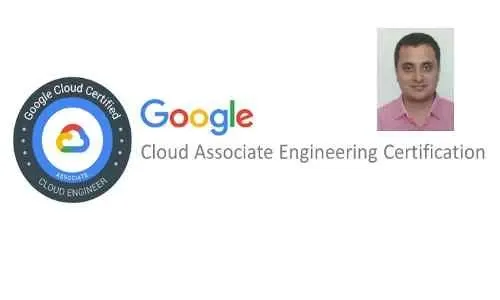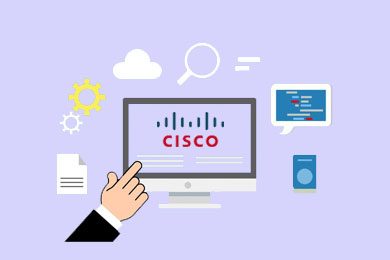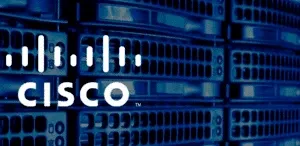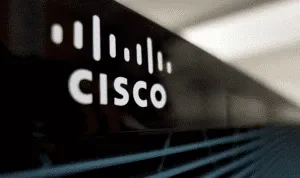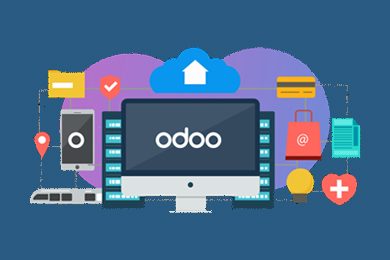This plan includes
- Limited free courses access
- Play & Pause Course Videos
- Video Recorded Lectures
- Learn on Mobile/PC/Tablet
- Quizzes and Real Projects
- Lifetime Course Certificate
- Email & Chat Support
What you'll learn?
- Complete understanding of all Google Cloud services required to be a Google Cloud Associate Engineer
- Students will lean about Google cloud and its services.
- Student can learn how Google cloud is different from other cloud
- What all computation options are available in Google cloud like compute engine, Cloud Function, Kubernetes
- How to decide which compute service should be use based on need
- Students will learn about data storage options like Persistent disk, Local Disk, Cloud SQL, Cloud DataStore, BigQuery
- What are various machine learning and AI offerings by Google cloud
- How to use load balancer in GCP
- What are the various data storing options in Cloud for different use case.
- How to capture logs for the application in log
- How to monitor and debug application in cloud
- How to use IAC to create cloud resources
- How CI/CD pipeline works in GCP
- Bigdata service in Google Cloud
Course Overview
This course will help you in becoming a Google Cloud Associate Engineer. It will help in learning what are the various cloud offerings in Google cloud platform and how to use those offerings.
This is an ideal course to learn about Google cloud for all developers and aspiring cloud engineers.
It will help in boosting your career.
This course covers
1. What is Cloud
2. Why use Google Cloud
3. How to use IAM in Google cloud and ensure security in Cloud
4 What are the compute offerings in GCP and how to use those compute offerings. It also covers where to use which compute offerings
5. What are the data storage services offered in Google Cloud and what are the best practices to store and analyze data in Google Cloud.
6. How to distribute request traffic among application backends using various load balancer options in GCP and how to decide which load balancer is best suitable for a particular use case.
7. Bigdata services in Google cloud
8. How to capture and analyze logs in GCP
10. How to monitor applications in Google Cloud
11. How to set up CI/CD pipeline in Google Cloud
Pre-requisites
- Just a basic understanding of Cloud computing is good enough for this course.
- Having a developer background will make it easy to understand the concepts defined in this course
- Basic understanding of big data and CI/CD pipeline will help in understanding the content in better way
Target Audience
- Any one who is interested in learning cloud technologies.
- Any one who want to be Google Cloud Associate Engineer
Curriculum 162 Lectures 04:04:13
Section 1 : Cloud Computing Introduction
- Lecture 2 :
- Computing Services and Challenges
- Lecture 3 :
- Benefit of Cloud
- Lecture 4 :
- Why Google Cloud
Section 2 : Introduction To Google Cloud
- Lecture 1 :
- Overview of Google Cloud Platform (GCP)
- Lecture 2 :
- Demo - Create GCP Account
- Lecture 3 :
- Demo - How to use Cloud Console
- Lecture 4 :
- Region And Zone
- Lecture 5 :
- Cloud Services
- Lecture 6 :
- GCP Interfaces
- Lecture 7 :
- Demo - Cloud Shell
- Lecture 8 :
- Demo - Cloud SDK Installation
- Lecture 9 :
- Cloud SDK Commands
Section 3 : Resource Management and IAM
- Lecture 1 :
- What is Resource
- Lecture 2 :
- Resource Hierarchy
- Lecture 3 :
- Resource Hierarchy Benefits
- Lecture 4 :
- Demo - Project Management
- Lecture 5 :
- Quota
- Lecture 6 :
- Billing Account Overview
- Lecture 7 :
- Payment Section Overview
- Lecture 8 :
- Billing Account Management
- Lecture 9 :
- Budget & Alerts
- Lecture 10 :
- Billing Export
- Lecture 11 :
- Pricing Calculator
- Lecture 12 :
- IAM Introduction
- Lecture 13 :
- What is Member
- Lecture 14 :
- What is Service Account
- Lecture 15 :
- What is Permission And Role
- Lecture 16 :
- Billing Account Related Important Roles & More
- Lecture 17 :
- Demo - Assign Role To Member
- Lecture 18 :
- Demo - Create Custom Role & Assign to IAM Member
- Lecture 19 :
- Demo - Service Account Creation
- Lecture 20 :
- What is Policy
- Lecture 21 :
- Policy Related Commands
- Lecture 22 :
- Organization Policy
- Lecture 23 :
- What is Audit Log
- Lecture 24 :
- Demo - Audit Logs
Section 4 : Compute Engine
- Lecture 1 :
- Compute Service Introduction
- Lecture 2 :
- Compute Engine Features and Use Case
- Lecture 3 :
- Machine Type & CPU Platform
- Lecture 4 :
- Demo - Machine Type
- Lecture 5 :
- Disk Types
- Lecture 6 :
- Demo - Create Disk
- Lecture 7 :
- What is Image
- Lecture 8 :
- Demo - Create Disk From Image
- Lecture 9 :
- Demo - Create Custom Image From Disk
- Lecture 10 :
- Networking for VM
- Lecture 11 :
- Demo - Start a VM instance & Configure Apache Web Server
- Lecture 12 :
- What is Snapshot
- Lecture 13 :
- Demo - Manual Snapshot Creation
- Lecture 14 :
- Demo - Create Snapshot Schedule
- Lecture 15 :
- Startup Script, Preemptive VM, On Host Maintenance & Auto Restart
- Lecture 16 :
- Demo - Detailed Steps for VM Creation and Starting Web Server via Startup Script
- Lecture 17 :
- What is Instance Template
- Lecture 18 :
- Demo - Create VM Via Instance Template
- Lecture 19 :
- VM Creation Flow With Startup Script & Instance Template
- Lecture 20 :
- Managed Instance Group
- Lecture 21 :
- Demo - Create VM Instance Using Managed Instance Group
- Lecture 22 :
- Pricing And Discount
Section 5 : Google App Engine (GAE)
- Lecture 1 :
- App Engine Introduction
- Lecture 2 :
- App Engine Comparison
- Lecture 3 :
- Traffic Migration
- Lecture 4 :
- Traffic Splitting
- Lecture 5 :
- Demo - Flexible Environment
- Lecture 6 :
- Flexible Environment
- Lecture 7 :
- Standard Environment
- Lecture 8 :
- Demo - Deploy Service in Standard Environment
- Lecture 9 :
- Demo - Create App Engine Application
- Lecture 10 :
- Microservice Architecture
- Lecture 11 :
- App Engine Application Components
- Lecture 12 :
- App Engine Features
Section 6 : Google Kubernetes Engine (GKE)
- Lecture 1 :
- Anthos Introduction
- Lecture 2 :
- Demo - Deploy WordPress Docker Image
- Lecture 3 :
- Deployment
- Lecture 4 :
- Volume Storage Options
- Lecture 5 :
- Service
- Lecture 6 :
- Labels & Selector
- Lecture 7 :
- Demo - Create Kubernetes Cluster
- Lecture 8 :
- Node Pool and Node Image
- Lecture 9 :
- Node and Pod
- Lecture 10 :
- GKE Architechure
- Lecture 11 :
- GKE Introduction
Section 7 : Serverless Computing - Cloud Function & Cloud Run
- Lecture 1 :
- Demo - Create Cloud Run Service
- Lecture 2 :
- Cloud Run Introduction
- Lecture 3 :
- Demo - Create Cloud Function
- Lecture 4 :
- How Cloud Function Works
- Lecture 5 :
- Cloud Function Introduction
Section 8 : Networking
- Lecture 1 :
- Networking Recap
- Lecture 2 :
- Cloud CDN
- Lecture 3 :
- Networking Basic Part1 - Private IP and Public IP
- Lecture 4 :
- Networking Basic Part2 - CIDR (Classless Inter Domain Routing)
- Lecture 5 :
- VPC Networking Introduction
- Lecture 6 :
- VPC Features
- Lecture 7 :
- Subnet Introduction
- Lecture 8 :
- Default VPC
- Lecture 9 :
- VPC Type
- Lecture 10 :
- Custom VPC With Auto Mode
- Lecture 11 :
- Custom VPC With Custom Mode
- Lecture 12 :
- Firewall Rules Introduction
- Lecture 13 :
- How to Create Firewall Rule
- Lecture 14 :
- IP Address
- Lecture 15 :
- Routes
- Lecture 16 :
- Shared VPC
- Lecture 17 :
- VPC Peering
- Lecture 18 :
- Bastion Host
- Lecture 19 :
- Nat Gateway Introduction
- Lecture 20 :
- Hybrid Networking Introduction
- Lecture 21 :
- Cloud Interconnect
- Lecture 22 :
- Connection Peering
- Lecture 23 :
- Cloud VPN
- Lecture 24 :
- Cloud Router
- Lecture 25 :
- Choosing Hybrid Connection
- Lecture 26 :
- Cloud DNS
Section 9 : Cloud Storage
- Lecture 1 :
- Storage Solution Introduction
- Lecture 2 :
- Cloud Storage Introduction
- Lecture 3 :
- Bucket & Object
- Lecture 4 :
- Demo - Bucket & Object
- Lecture 5 :
- Storage Classes
- Lecture 6 :
- Object Lifecycle Rules
- Lecture 7 :
- Data Security - Access Control
- Lecture 8 :
- Public Access to Objects
- Lecture 9 :
- Signed URL
- Lecture 10 :
- Data Encryption Keys
- Lecture 11 :
- Data Transfer Options
- Lecture 12 :
- Object Versioning
Section 10 : Database Options in GCP
- Lecture 1 :
- Cloud SQL Introduction
- Lecture 2 :
- Cloud SQL Features
- Lecture 3 :
- Demo - Create MySQL Instance
- Lecture 4 :
- Demo - Create Database and Tables
- Lecture 5 :
- Import Database
- Lecture 6 :
- Cloud Spanner Introduction
- Lecture 7 :
- Cloud Spanner - Use Case
- Lecture 8 :
- Cloud Datastore Introduction
- Lecture 9 :
- Datastore Vs RDBMS
- Lecture 10 :
- Demo - Use Firestore in GCP
- Lecture 11 :
- Bigtable Introduction
- Lecture 12 :
- Bigtable - Features & Use Case
- Lecture 13 :
- BigQuery Introduction
- Lecture 14 :
- Demo - Use BigQuery Public Dataset
- Lecture 15 :
- Demo - BigQuery Create Own Dataset
- Lecture 16 :
- Choose Right Data Storage Service
- Lecture 17 :
- Cloud Spanner - Comparison With Other Database
Section 11 : Big Data Services
- Lecture 1 :
- Big Data Introduction
- Lecture 2 :
- Dataproc Introduction
- Lecture 3 :
- Demo - Dataproc Cluster Creation
- Lecture 4 :
- Demo - Dataproc Job Submission
- Lecture 5 :
- Dataflow Introduction
- Lecture 6 :
- Apache Beam Key Concepts
- Lecture 7 :
- Dataflow vs Dataproc
- Lecture 8 :
- Cloud Pub/Sub Introduction
- Lecture 9 :
- Pub/Sub Concepts
- Lecture 10 :
- Demo - Topic & Subscription Creation
- Lecture 11 :
- Demo - Publish Message
Section 12 : Cloud Operation Suite
- Lecture 1 :
- Logging And Monitoring Introduction
- Lecture 2 :
- Demo - Cloud Logging
- Lecture 3 :
- Demo - Log Metrics
- Lecture 4 :
- Cloud Monitoring Introduction
- Lecture 5 :
- Demo - Metrics Explorer
- Lecture 6 :
- Other Operation Tools
Section 13 : IAC & CI/CD
- Lecture 1 :
- IAC - Deployment Manager
- Lecture 2 :
- Demo - Deployment Manager
- Lecture 3 :
- CI/CD Pipeline
Our learners work at
Frequently Asked Questions
How do i access the course after purchase?
It's simple. When you sign up, you'll immediately have unlimited viewing of thousands of expert courses, paths to guide your learning, tools to measure your skills and hands-on resources like exercise files. There’s no limit on what you can learn and you can cancel at any time.Are these video based online self-learning courses?
Yes. All of the courses comes with online video based lectures created by certified instructors. Instructors have crafted these courses with a blend of high quality interactive videos, lectures, quizzes & real world projects to give you an indepth knowledge about the topic.Can i play & pause the course as per my convenience?
Yes absolutely & thats one of the advantage of self-paced courses. You can anytime pause or resume the course & come back & forth from one lecture to another lecture, play the videos mulitple times & so on.How do i contact the instructor for any doubts or questions?
Most of these courses have general questions & answers already covered within the course lectures. However, if you need any further help from the instructor, you can use the inbuilt Chat with Instructor option to send a message to an instructor & they will reply you within 24 hours. You can ask as many questions as you want.Do i need a pc to access the course or can i do it on mobile & tablet as well?
Brilliant question? Isn't it? You can access the courses on any device like PC, Mobile, Tablet & even on a smart tv. For mobile & a tablet you can download the Learnfly android or an iOS app. If mobile app is not available in your country, you can access the course directly by visting our website, its fully mobile friendly.Do i get any certificate for the courses?
Yes. Once you complete any course on our platform along with provided assessments by the instructor, you will be eligble to get certificate of course completion.
For how long can i access my course on the platform?
You require an active subscription to access courses on our platform. If your subscription is active, you can access any course on our platform with no restrictions.Is there any free trial?
Currently, we do not offer any free trial.Can i cancel anytime?
Yes, you can cancel your subscription at any time. Your subscription will auto-renew until you cancel, but why would you want to?
Instructor

147211 Course Views
3 Courses



 Tech & IT
Tech & IT
 Business
Business
 Coding & Developer
Coding & Developer
 Finance & Accounting
Finance & Accounting
 Academics
Academics
 Office Applications
Office Applications
 Art & Design
Art & Design
 Marketing
Marketing
 Health & Wellness
Health & Wellness
 Sounds & Music
Sounds & Music
 Lifestyle
Lifestyle
 Photography
Photography



